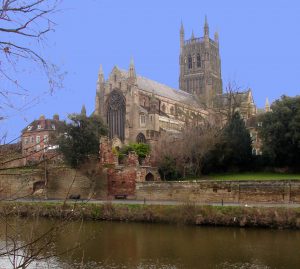King Richard’s Sword, the sixth book in my Lady Apollonia West Country Mysteries, is set in Worcester, England, in the years, 1399-1400.
The town of Worcester features important remnants from the medieval period. Its cathedral, which before the dissolution of the monasteries by King Henry VIII, was a powerful priory church is extraordinary. I have used the priory cathedral in my story and refer to some of its surviving buildings. The cathedral church itself is much as it was in 1399 and alive today as the home of a worshipping community as well as the seat of the Anglican bishop of Worcester. The cathedral’s crypt houses a small museum where I learned that archaeologists have on display certain remains of a medieval pilgrim whom I chose to weave into my story.
Some of Worcester’s other buildings from the medieval period and some sections of its medieval wall still exist. The Water Gate of the wall and many of the streets in the city centre are where they were 600 years ago. Some of the ancient buildings were residences in the medieval period but one of the most interesting collections of old buildings is the Commandery, located just outside the wall where the Sidbury Gate had been. Now, it is a museum, but in the fourteenth century, it was an important hospital named for St. Wulfstan, one of Worcester’s local saints.
